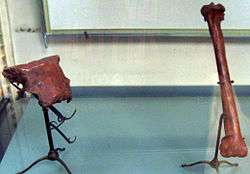Sylviornithidae
| Sylviornis Temporal range: Holocene | |
|---|---|
 | |
| Sylviornis neocaledoniae skull fragment and tibia, Muséum national d'histoire naturelle, Paris | |
| Scientific classification | |
| Kingdom: | Animalia |
| Phylum: | Chordata |
| Class: | Aves |
| Order: | Pangalliformes |
| Family: | †Sylviornithidae Mourer-Chauviré & Balouet, 2005 |
| genera | |
Sylviornithidae is an extinct family of flightless birds. Traditionally assumed to be within Galliformes, recent phylogenetic studies showcase that they rest outside of the galliform crown-group, making them the most recently lived non-galliform Pangalliformes.[1] For the longest time it has been used as a monotypic family for Sylviornis, but recent studies showcase that Megavitiornis was part of this clade as well.[2]
References
- ↑ Worthy, T., Mitri, M., Handley, W., Lee, M., Anderson, A., Sand, C. 2016. Osteology supports a steam-galliform affinity for the giant extinct flightless birds Sylviornis neocaledoniae (Sylviornithidae, Galloanseres). PLOS ONE. doi: 10.1371/journal.pone.0150871
- ↑ Worthy, T., Mitri, M., Handley, W., Lee, M., Anderson, A., Sand, C. 2016. Osteology supports a steam-galliform affinity for the giant extinct flightless birds Sylviornis neocaledoniae (Sylviornithidae, Galloanseres). PLOS ONE. doi: 10.1371/journal.pone.0150871
This article is issued from Wikipedia - version of the 11/9/2016. The text is available under the Creative Commons Attribution/Share Alike but additional terms may apply for the media files.